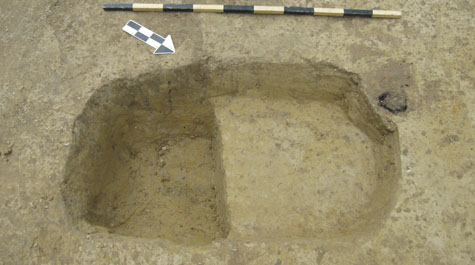Bone fragments represent unprecedented discovery
The discovery represents a significant scholarly mystery, as researchers both at WMCAR and in the College's Department of Anthropology say that evidence of the formal interment of dogs dating from the Colonial period is unprecedented.
Joe Jones, WMCAR director, said the nature of the burial sites and the deteriorated condition of the remains pointed toward interpretation that the sites held the remains of young children. Both graves were carefully excavated rectangular shafts, consistent with human burials. In addition, Jones said the graves were aligned east and west, congruent with Christian burial practices of the Colonial period.
"When we first identified the sites, we treated the remains as human because they were buried like people," Jones said. WMCAR archaeologists discovered the two graves on July 13. They were monitoring the removal of the paving of James Blair Drive, an element in an ongoing effort to avoid damage to William & Mary's archaeological heritage during construction work. The James Blair work is part of a larger project involving installation of piping for a new heating and cooling system.
Jones said that whenever they uncover suspected human remains, established protocol requires that archaeological work be stopped and the find reported to the Virginia Department of Historic Resources (VDHR).
"If we get an inkling they might be human graves, we stop work and report it. We don't take any chances," Jones said. With the state's approval, the contents of the graves were extracted from the sites behind Tucker Hall and taken to the WMCAR labs on campus. Work on the piping project resumed shortly thereafter.
Jones said that each grave held only a scant handful of remains dispersed throughout the soil matrix filling the graves. Most of the individual pieces were smaller than a fingernail. WMCAR faunal expert Elizabeth Monroe was able to make a conclusive determination of the remains only after separating the bones from the soil, Jones said.
WMCAR has dated the graves to the late 17th to mid 18th Century. Jones and other researchers have said that they know of no other formal interments of dogs from the early Colonial period.
"I don't know of any instance of the formal, intentional interment of animals in the 18th Century, either dogs or cats," said Joanne Bowen, a research professor in William & Mary's Department of Anthropology and zooarchaeologist at the Colonial Williamsburg Foundation. "We find them in the 19th Century. But in the Colonial period, people didn't think of their dogs and cats in the same way we do now."
Jones added that excavations of prehistoric Native American sites sometimes reveal dog burials, but those features are typically oval-shaped and do not have the east-west alignment, typical of Christian burials of the historic period.
"There has been no shortage of archaeology on domestic sites of this particular time period throughout the Mid-Atlantic region," Jones said. "And despite a long history of such investigations, we know of no documented or undocumented examples of dog burial features like this on sites occupied during the early Colonial period."
















